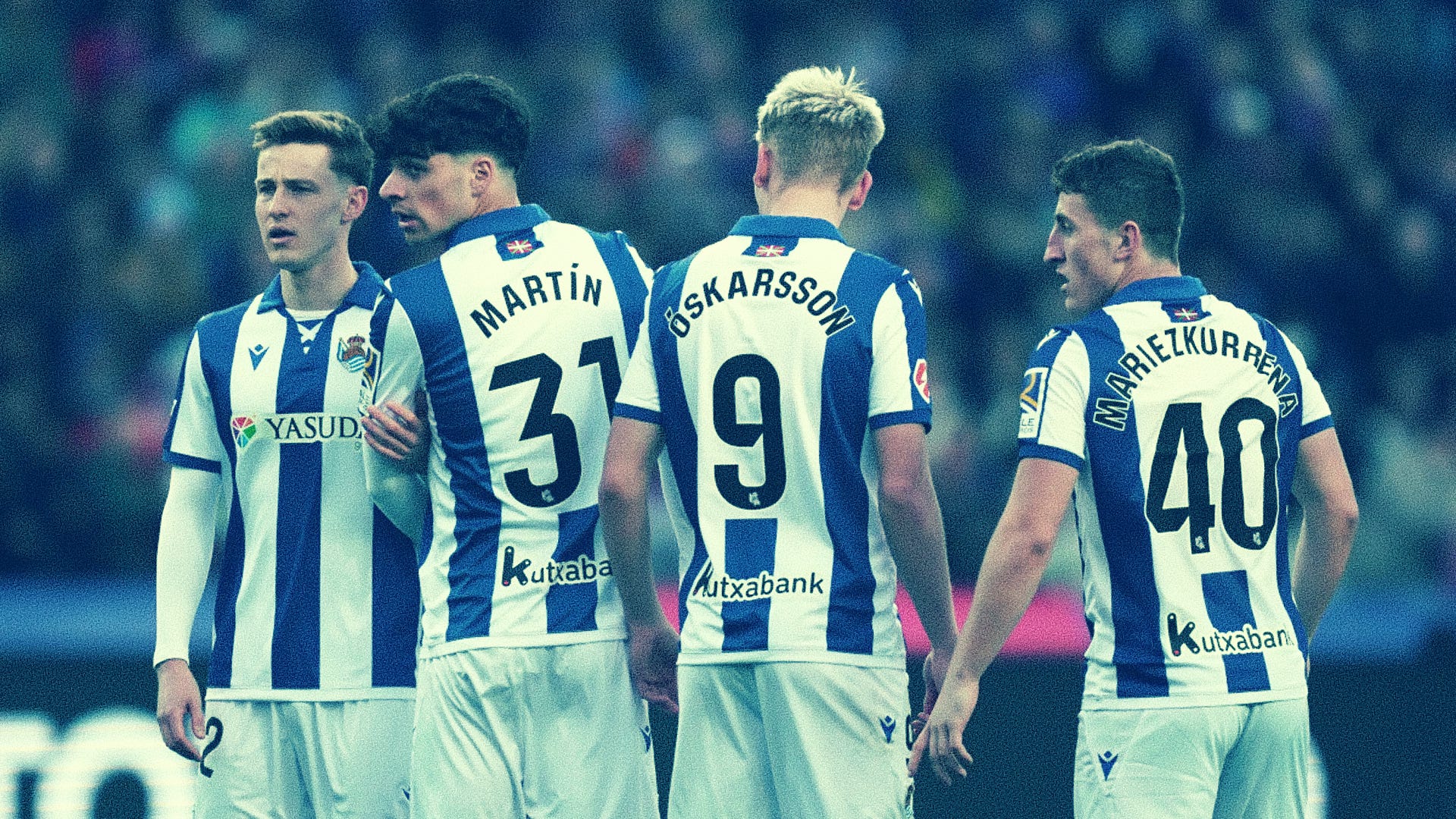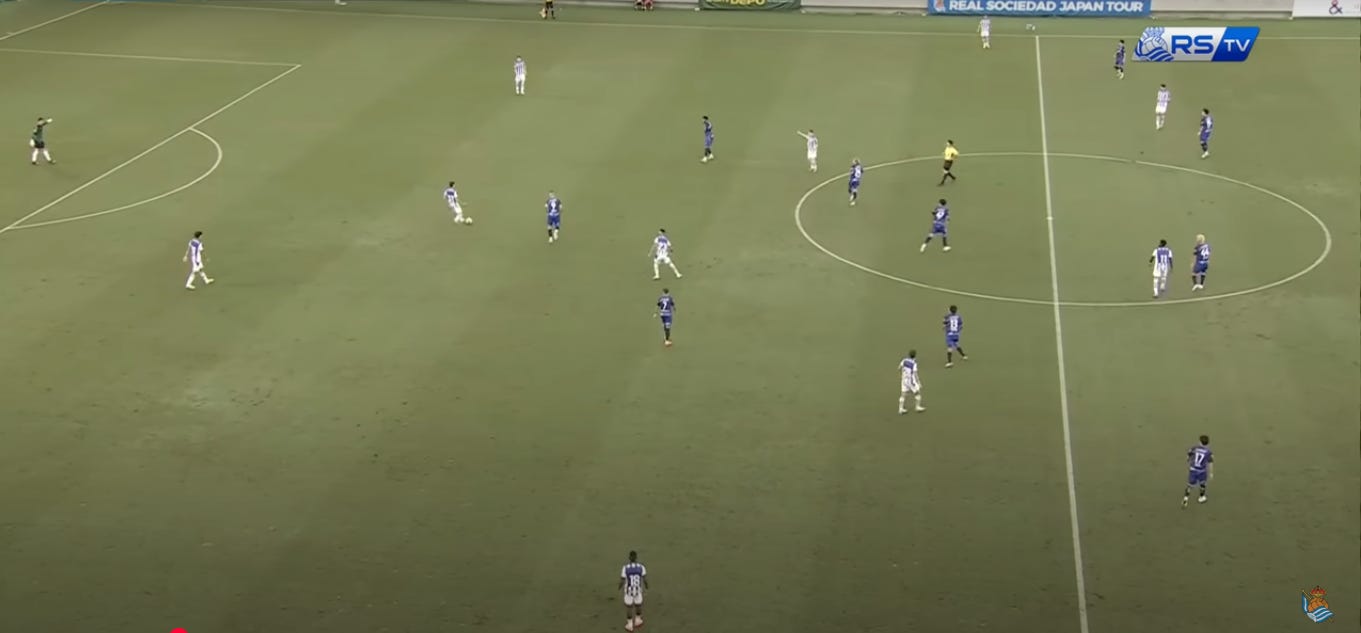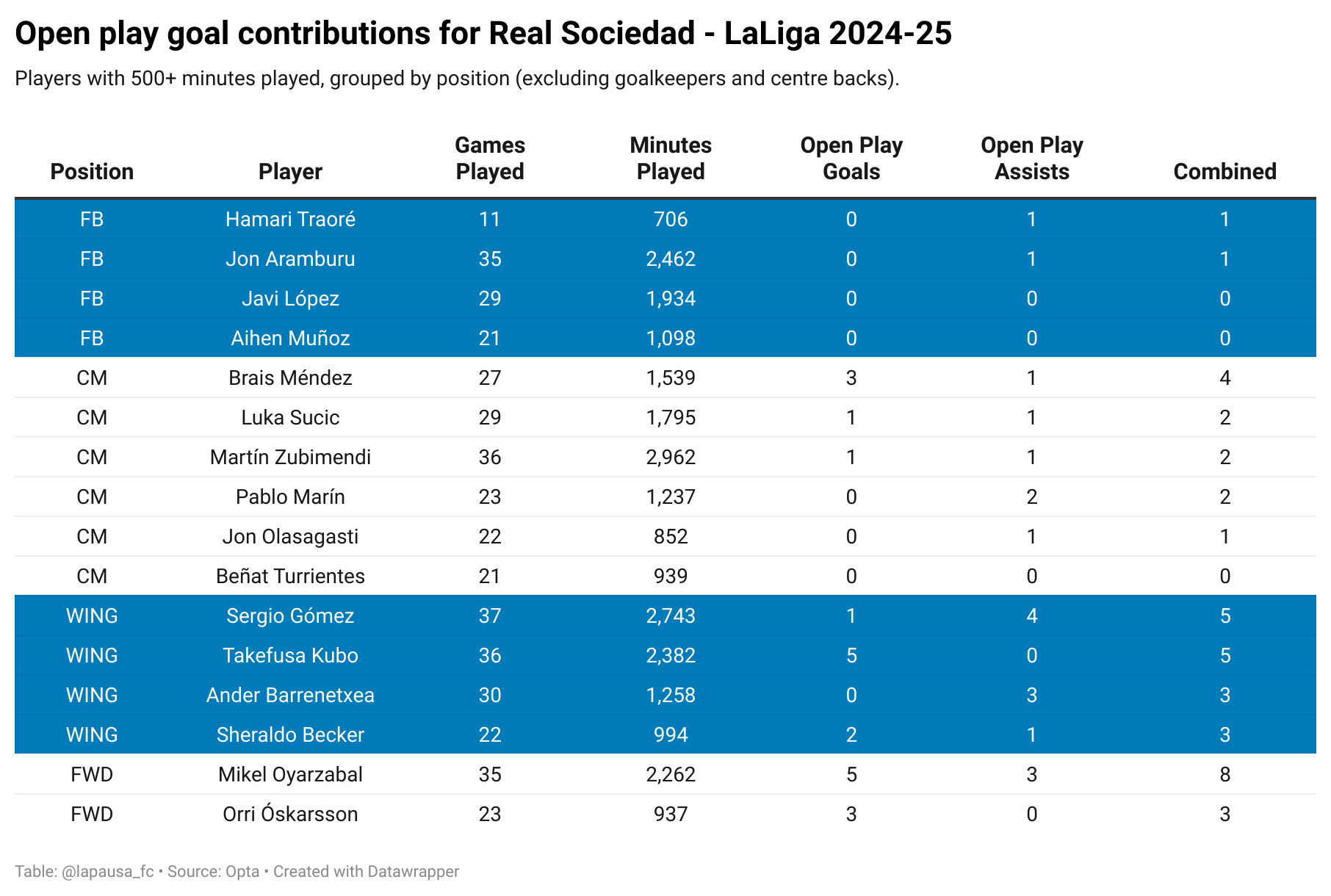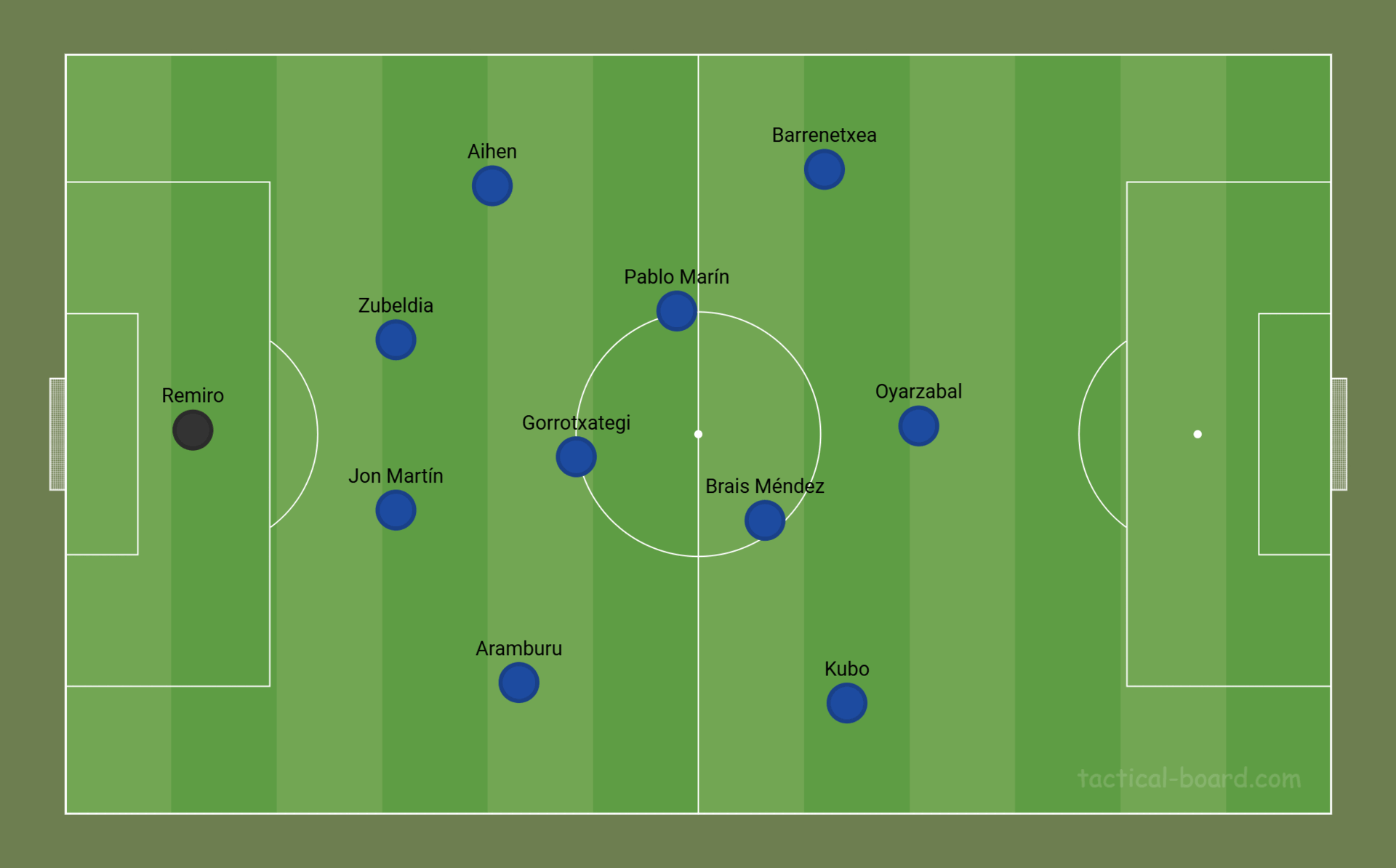Thoughts on... Real Sociedad
La Real have promoted Sergio Francisco to the top job following the end of the Imanol Alguacil era, leaving us with plenty of questions to work through.
The “Thoughts on…” series by La Pausa comes out of our ongoing conversations about Spanish football. Robbie and Jamie are always breaking down team projects, players and tactical nuances, so we’ve turned those chats into clear, edited articles, complete with graphics, for a sharper, more engaging read.
The reign of Imanol Alguacil is over — and on balance, it was a mighty good one. Even if his final campaign turned out to be a pretty tough watch, there’s no denying that he’s left a high bar for the man who will now resume the story: Sergio Francisco.
While some will look at the appointment of Real Sociedad’s new manager as underwhelming — mainly in that they’ve promoted internally instead of going after a ‘bigger (proven) fish’ — it’s not a surprising decision if you’ve been following the club’s trajectory and messaging over the years.
At a club who work towards more than half of their first team squad being made up by players from their Zubieta academy, it makes plenty of sense to hire the man who’s been most involved in the day-to-day there over a long period.
In fact, while it’s logical to think Sergio Francisco is an inferior manager to Imanol Alguacil at this stage, remember that he too was an internal promotion and unknown to most at the time. As noted by the club’s President Jokin Aperribay, if we were to compare the merits of the likes of Alguacil, Jagoba Arrasate and Sergio Francisco — three men who’ve risen to the top job in the modern era — then it’d actually be the latter who has produced the most convincing case as far as coaching talent goes.
It’s fair to question whether Europe in itself, or restoring the team to the non-2025 levels of the Alguacil era, should continue to be expected though. The recent comments made by Take Kubo on their pre-season tour of Japan might have seemed like those of a player thinking about his future, but they contained plenty of truth about where the club is at now, compared to where it has been.
“When I came here I was surrounded by David Silva, Mikel Merino, [Martín] Zubimendi, Brais [Méndez], all those types… and I didn’t have to take that type of responsibility… [Alexander] Isak was here and then left,” said Kubo. “People say that it’s a cycle, but I think with a club that, according to the President who always told me that every season he was aspiring to win LaLiga… well I think to win LaLiga you need something extra.”
La Real’s new regime will have all the intention of continuing to be among the six or seven best teams in LaLiga, but there’s a whole lot of process that’s going to be important too. There’s no obvious restoring of what previously worked and player turnover, as Kubo mentions, will necessitate change to move forward.
▶️ What should we expect from the new man?
Well, Sergio Francisco is the only current LaLiga manager who has never overseen a match within the top two divisions of Spanish football. There’s not an overwhelming amount of certainty as to what he is or isn’t at this stage — we’re going to learn plenty about him as we go.
As for what we can say now, we know that the new manager isn’t going to come in with majorly pre-conceived ideas and create a radically different approach. There has still been plenty of football played in pre-season that looks like what we had seen for years under Alguacil, such as the trademark ‘up-back-through’ between their defence and midfield in a 4-3-3.
Real Sociedad shift the ball around their defence, before one of their interiors times a quick run back towards the ball and plays a first-time pass to the pivote, thus allowing him to face the play unmarked. It was a staple pattern of play under Alguacil (and clearly isn’t going anywhere).
Although Sergio Francisco has used the main systems of the Alguacil era during pre-season — 4-3-3 and the 4-4-2 rombo — we do have a pretty good sense that Real Sociedad are going to be less fixed in those this year. The new manager used a variety of systems in his work with the B team, and won’t hesitate to make alterations there if needed. “I think he wants us to be comfortable in different systems so that, depending on the opponent, we can surprise [them] more,” was one particular read by Sergio Gomez, speaking to MARCA.
Expect there to be more pragmatism in a global sense, too. Real Sociedad’s modus operandi in the previous regime was all about their intense off-ball approach, recovering the ball high and being dominant in their duels. And make no mistake, we’ll see plenty of aggression from this team as well, who will still load up plenty of man-to-man marking all over the pitch in moments. However, we are likely to see more intentionally varied approaches in 2025-26.
“There will be days where we have 60% possession and others where we allow [the opposition] possession to play a different way,” Sergio said last month.
We’ll have to wait and see on the extent of that, as La Real will still have plenty of intention (and quality) to control games themselves. And on that note, look for them to play quicker when building possession this season — Sergio has referenced his desire to be more vertical than they were last term, which can be translated as simply playing forward more readily (without massive structural changes).
Indeed, that brings us on to the next stop… precisely what Real Sociedad are going to do about the collapse in attacking productivity they suffered last term.
🎲 What is the big change we’d like to see?
This is an easy one (and already spoiled). It is, however, much easier to ask for than it is to implement for a manager; the guy who has to consider the knock-on effects and overall balance of the team at every moment.
As Rafa Benítez once said: "If you cover your head, your feet are cold; if you cover your feet, your head is cold.”
With that said, Real Sociedad just felt too predictable on the attacking front last season. They scored 31 non-penalty goals in 38 league games, and it was their worst campaign of the Alguacil era for non-penalty xG (39.97). There is, of course, some sort of finishing underperformance also at play there, but the feel of their attack was pretty arduous for most of the campaign and emblematic of a cycle coming to its end.
For some idea of their struggles last term, here’s a breakdown of their goal contributions from open play in LaLiga (featuring some pretty instructive and startling points):
🔻Their full backs directly contributed to just two open play goals in league competition (from a combined 6,200 minutes played)
🔻Only two non-strikers scored more than two open play goals in LaLiga (Take Kubo and Brais Méndez)
🔻Their leader for open play goals & assists was Mikel Oyarzabal with eight — only Getafe (Christantus Uche, 7) and Girona (Cristhian Stuani, 7) had leaders with fewer
The solution? If they want to score more goals, it seems unavoidable that Real Sociedad are just going to have to be willing to take more risks to generate opportunities — whether it’s positionally or bringing a different mindset. La Real are probably going to have to uncover their feet more than they did, and there’s a fair case to be made that it’s the best thing they can do.
Being quicker in circulating the ball and finding their wingers earlier seems like an immediate way they can claw back some ground. In pre-season, we’ve seen faster passing from the back and more bodies attacking the box when La Real have been able to accelerate up the pitch. And certainly, Sergio Francisco certainly seems to be looking for more aggression in attack in those moments.
“Recovering goals is an absolute priority,” he said in a recent interview, before adding that the idea is to create the conditions where multiple players can be chipping in 8-10 goals, instead of one player accounting for the majority of the team’s haul.
For that, La Real are going to have to be harder to read and more aggressive in looking for goal as a collective.
🧠 How to make sense of the post-Zubimendi midfield?
A week out from the season, Real Sociedad are still yet to go to the transfer market to sign an obvious Zubimendi ‘replacement’. We don’t know whether anything will happen on that front, so for the time being, all we can do is analyse the current picture.
Speaking on their options last month, Sergio Francisco said: “[Jon Gorrotxategi] has played a lot with me and we don’t have any secrets. I see him with the personality to be important and with the ability to play for La Real. He can perfectly be a starter, but just like Urko [González de Zárate] or [Beñat] Turrientes — that’s something we have to choose.”
For the moment, the strongest sense have as far as individuals go is that Gorrotxategi is best positioned to take up that deeper role. He was outstanding at Mirandés last season, has worked extensively with Sergio Francisco before, and has shown plenty of his selling points in pre-season.
It wouldn’t exactly be a stunning development if they did opt to start, say, Urko González de Zarate as the pivote come opening day. He performed well on loan at Espanyol last term and has the advantage in LaLiga experience. But most indicators do point towards Gorrotxategi being the preferred deep midfielder for the moment.
If that is indeed the case, the question is then: does he play as the lone pivote, or do Real Sociedad need extra support?
La Real could use a clearer 4-2-3-1 to reinforce that area (a system SF has used previously and in pre-season), or simply modify the roles in the 4-3-3 to let Brais Méndez play higher and offset that with the other interior being more attentive in deeper areas.
If we had to make our best guess now, a 4-3-3 with Gorrotxategi as the pivote and Pablo Marín-Brais Méndez as interiors will be the initial idea. If it’s not the case in the opener, what with it being away to Valencia at an intimidating Mestalla and a place where you might prefer an extra body in midfield, it at least looks their best bet back at the Reale Arena.
(The caveat being that Luka Sučić is very likely their best and most valuable central midfielder, and should eventually be a starter once they’ve kicked off the pre-season rust and context that goes with it. Similarly, getting Orri Óskarsson into the XI will no doubt be something they’ll look for as the new season progresses.)
🌠 Which new youngsters do we need to about?
Zubieta is one of the most productive academies in Spanish football, and the decision to give Sergio Francisco in the top job gives us a pretty clear direction of travel as far as its prominence in the new regime will go.
La Real will make use of their academy — and similarly, Sergio Francisco’s ability to guide them through and create new first team players will be a big aspect of how he’s assessed in his new role. Not everything will be about pure results.
Here are the names we expect to be part of that in the short term (who weren’t involved in LaLiga last year):
Jon Gorrotxategi (Central midfielder, 22)
See above… and here for a more detailed individual analysis.
Iñaki Rupérez (Right back, 22)
One of the big winners of pre-season, Iñaki Rupérez looks set to stick around in the first team picture. We know that from his performances and the fact that Hamari Traoré will soon be allowed to leave, which will make Jon Aramburu the starting option and push Rupérez up the depth chart.
The 22-year-old is a different prospect to the feisty defensive stopper that is Aramburu, standing out more for his contribution in attack than defence. He’s sufficiently athletic to get up and down the wing at speed, and he packs plenty of quality with his final ball — be it a pass or cross.
In the event La Real end up using plenty of the 4-4-2 rombo this season — which necessitates full backs who stretch the play — Rupérez’s attacking tools could become especially useful.
Mikel Goti (Attacking midfielder, 23)
Signed from Athletic Club in 2023, Mikel Goti is an attacking midfielder with plenty of poise and an eye for goal. Watch him play and he looks like something from a different era, such is his lanky, gliding style.
He’s also at the point where he is outgrowing the B team and is starting to position himself for first team minutes, but might find himself caught in between. In short, Real Sociedad’s midfield options are abundant, and he’s a specialist no. 10 who’s unlikely to find minutes as an interior. Getting the real time experience he’d need to try and make that adaptation will be hard too.
It’d be a truly welcome surprise if he does manage to carve out a place for himself as a contributor — he certainly has the talent that projects for this level — but you wouldn’t bet on it from here.
Jon Karrikaburu (Striker, 22)
Real Sociedad’s priority as far as the striker position goes has to be Orri Óskarsson. Quite simply, he’s better, more valuable and younger than Jon Karrikaburu. However, it feels like there’s still a role to be played by the 22-year-old given the arrival of Sergio Francisco, a coach he’s worked with previously.
Karrikaburu’s development hasn’t quite been as ascendent as it once looked like it was going to be, but he’s a solid centre forward who brings plenty of hustle, occupation of centre backs, and smart hold-up play. Whether he comes on for short sub cameos or helps lighten the load on Mikel Oyarzabal, he’s someone that La Real can look to for dependable minutes in leading the line.








